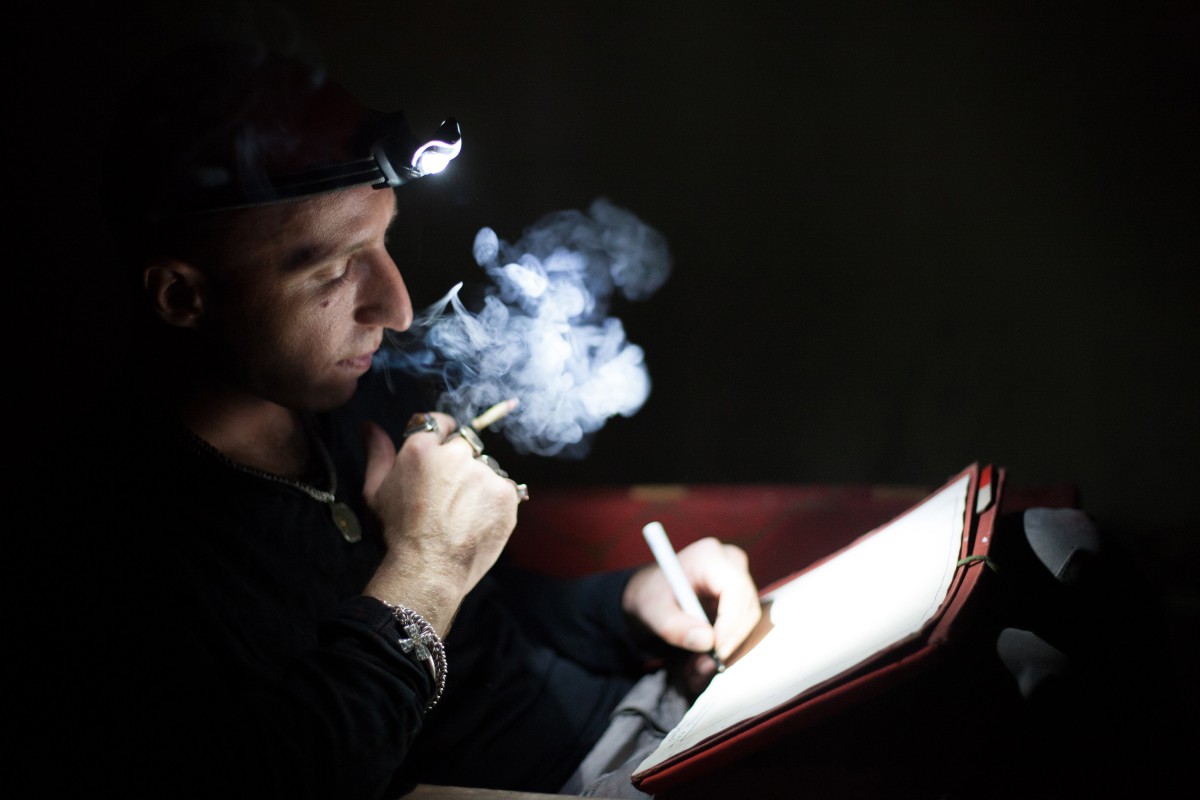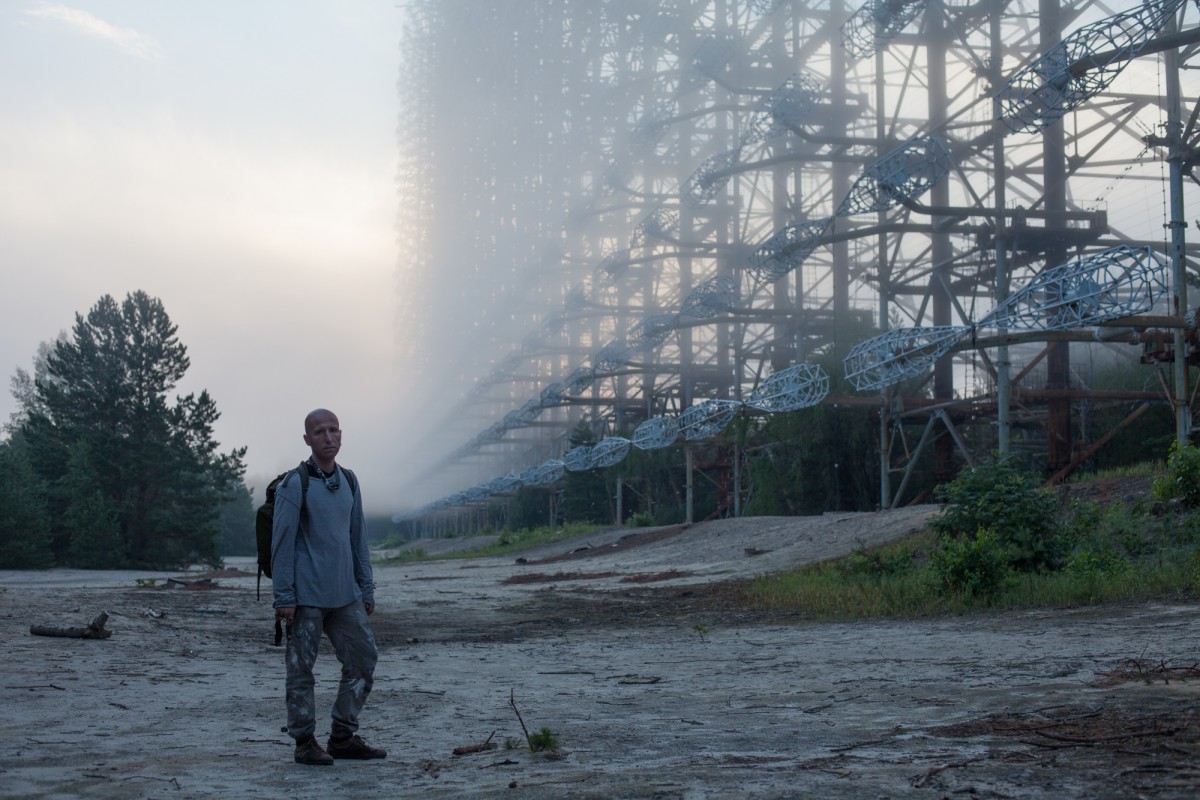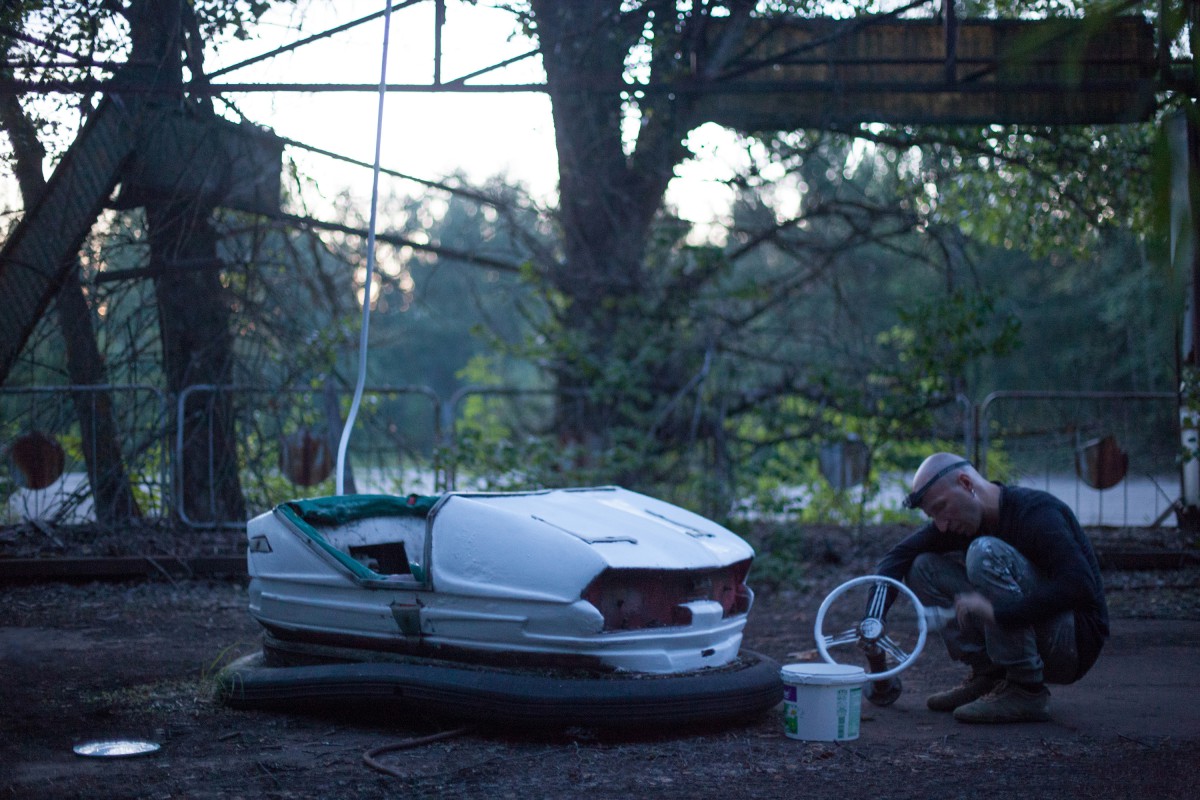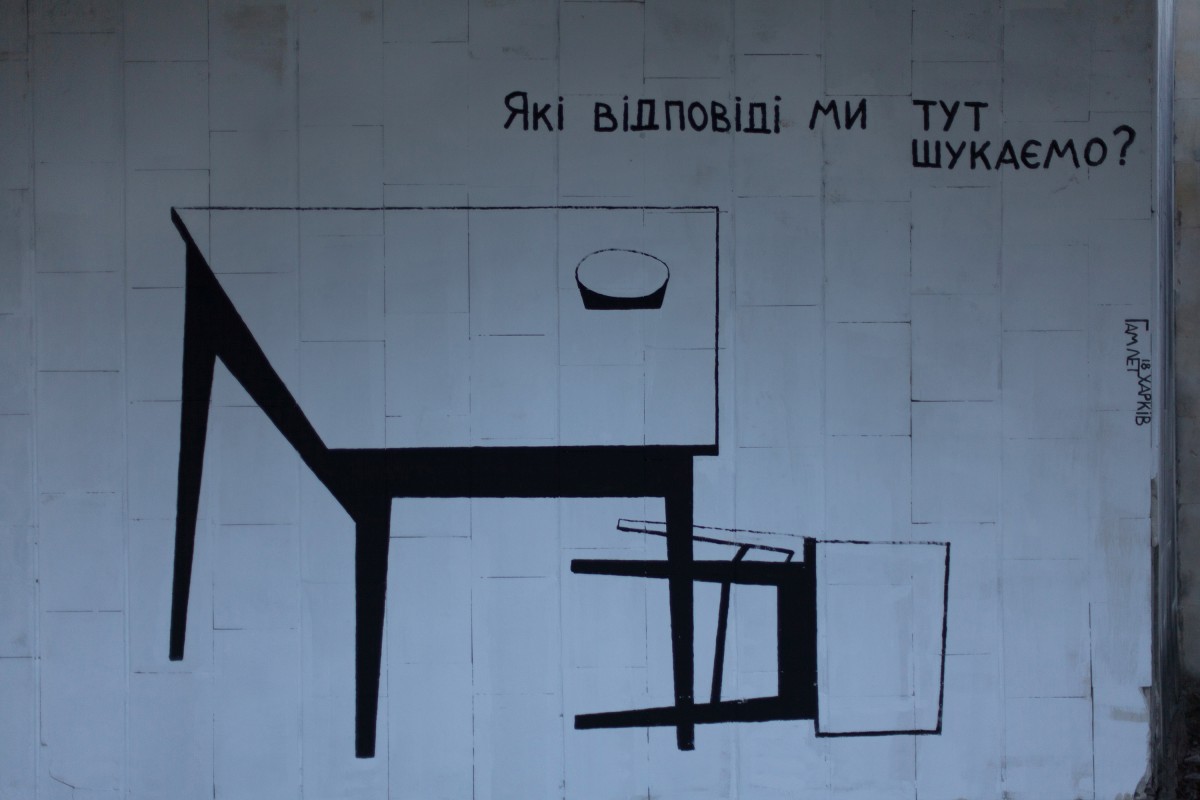Before the Chornobyl meltdown, Prypiat was home to almost fifty thousand people. It was a symbol of the future: a thriving city populated by young nuclear scientists who were offered high wages and a wider selection at grocery stores. The city even had a supermarket, which was a tremendous luxury in the Soviet Union. Prypiat was built according to the best practices of the day—it had more than enough schools and daycare centers, and green spaces harmoniously complemented residential areas. Even the street layout was designed to eliminate traffic jams. Thirty-three years ago, Prypiat looked like a monument to civilization in the middle of a pine forest ocean. Then people abandoned it, and the town turned into an eerie wasteland.
I smuggled Gamlet into the Chornobyl Exclusion Zone. A nineteen-mile zone around the power plant has been off limits since the meltdown in 1986. You can’t go there without getting a special permit, let alone do street art. I’ve never been one to grovel, so I don’t have any special permits. Over the past seven years or so, I’ve been sneaking people in, like the protagonist of Andrei Tarkovsky’s Stalker.
I’m sitting on the cracked asphalt, pressing my hand against a clump of radioactive moss. It’s not that I don’t care about my health. The thing is, there isn’t much radiation here anymore, but even if there were, humans can get used to just about anything, anyway. “If there’s no dosimeter, there’s no radiation,” I tell Gamlet.
Gamlet is a Ukrainian street artist. Running his roller dipped in thick white paint along the wall, he says that his name has nothing to do with Shakespeare’s hero and that in Russian, gam let means the noise of years passing by, the commotion of the era in which we live.
Later, he admits that he was creeped out after I fell asleep. The dead town’s silence hovered over him, and he thought about waking me up. I could see why, though—it’s Gamlet’s first night in the Zone.
*
It took us two days to get there. First, it was a long taxi ride from Kyiv. Then we stealthily scaled a barbed wire fence—the Chornobyl Zone border—and trudged through a thick pine forest, dying from exhaustion as we hauled Gamlet’s abundant reserves of matte wall paint.
Twenty-five miles of forest, dirt paths, and an empty road—that’s our route. We head out after nightfall so the police won’t catch us. You can easily cover this much ground over the course of a single night, but summer nights are short, and the heavy paint cans slow us down, making our task even more challenging. A few hours later, my knock-off Chinese-made sneakers are giving me bad blisters.
The exclusion zone is not just Prypiat, Chornobyl, and the nuclear power station. It encompasses hundreds of deserted villages, Gamlets, and other places. Summer camps, ranger stations, military bases, churches, and bridges. The Zone is three-quarters the size of Long Island. It takes two days to walk from the border of the Zone to Prypiat. Or three, if it is winter and you’re trudging through knee-deep snow along the abandoned stretch of railroad. The vastness and the variety of the barren terrain make you feel like you’re in an entirely deserted country.
Before nightfall, we finally make it to a ghost village. I shine my headlamp around in the thicket for a while until we come upon a house with no broken windows. We shed our backpacks and then start breaking down a fence for firewood.
Once we light up the stove, Gamlet sits down to sketch the pieces he’ll be doing in Prypiat. His fingers are heavy with rings, his face invisible behind a thick veil of cigarette smoke. Through that wall of tobacco, he tells me how he used to draw portraits of hobos when he himself was living in communal apartments.
His works address grim Ukrainian reality. They are black-and-white fragments of a wretched existence encased in succinct verbal Tao. In one of his paintings, there’s a pair of gloves that belonged to a shell-shocked soldier who’d left them at home but later forgot where his home was. Another one shows a solitary garage, and it’s called “my metal home.”

Gamlet wordlessly takes one more rolled cigarette out of his silver tin and lights it. Figuring I should just let him paint, I walk out of the house to get some water. Wading through knee-high grass and thick fog, I eventually reach a brook under a bridge and then kneel down on the bank. Aiming my headlamp at the dark surface of the water, I plunge my hand in. The river is insanely cold—at first, my hand locks up, but I get used to it as the water fills up my flask.
Our route toward Prypiat runs past the gigantic Chornobyl-2 radar. It was built to monitor ballistic missile launches from the US—it would’ve given the Soviets enough time to strike back. The radar would disrupt radio signals all over the world whenever it was turned on. During the Cold War, the radar was nicknamed “The Woodpecker,” since the interference sounded like the bird’s repetitive tapping.
The radar is drowning in the fog. Its majestic, anti-natural shape in the middle of the thick forest turns the morning into a surreal fairy tale. The radar is higher than the Great Pyramid of Giza, and it stretches out for a half-mile. Dissolving in the gray oatmeal of the fog, it seems to go on forever.
I’m a little tired by the time we pass the radar. No wonder, as it’s twice as long as the Manhattan Bridge and as big as two dozen Eiffel Towers lined up alongside each other.
The radar is so high that I usually have to take two long breaks before I get to the top of the endless metal ladders. Climbing it is pretty dangerous; last year, a stalker fell to his death. It’s worth the risk, though, since you can see the entire Zone from the top: Prypiat, the Chornobyl nuclear power station, and the forest stretching out to the horizon. It’s a shame we don’t have the time or energy to climb the radar now.

The first rays of sunlight fall onto the radar’s rusted bones. A roe deer’s hooves patter in the thicket nearby. A duck with a broken wing jumps up and down on the sand right at our feet, trying, again and again, to take off. I aim my headlamp at it, and we both realize it’s doomed. “It’ll be reborn as someone else,” Gamlet says, trying to assuage my concerns.
We reach Prypiat in the evening, and I pick an apartment in the part of town that looks the most like a jungle. That way, there’s less of a chance we’ll bump into the police. They prowl around the town at night, looking for light in the dark windows of the dead apartment blocks.
We scour a nine-story building, lugging tables and chairs to an apartment with no broken windows. We find all the furniture we need to spend the night, rest for a bit, and then head downtown, scoping out the pier and the Palace of Culture. Then we stop at an amusement park, where Gamlet chooses one of the little rusty bumper cars for his first piece.
He resurrects it, painting it neatly in white. This one is now special, compared to the other old cars. Gamlet calls it a “wonderful exception.”

On our way out of the amusement park, we suddenly hear a real car and we drop down into the high grass, unnoticed. The car is crawling along the street, its sallow lights flooding the darkness. It’s the police or someone worse yet—it’s past curfew, so it can’t be innocent tourists cruising around town.
We regain our composure pretty quickly and then start looking for our next spot. Gamlet picks a wall between the Enerhetyk Palace of Culture and the Polissia Hotel. I plop down and aim my light at the wall, while he paints in black and white.
There already is some street art in Prypiat: darkened silhouettes like permanent shadows in Hiroshima, almost photo-realistic bears and deer, and indecipherable urban-style slogans. Graffiti artists aren’t the only ones trying to revive the town, though—stalkers have put neon lights on the signs lining abandoned high-rises, restored slogans painted on the roofs, and brought treasures from all over the neighborhood back to their apartments to spruce them up and bring them back to life. I’ve celebrated New Year’s in Prypiat a couple of times.
There aren’t enough stalkers to pack soccer stadiums yet, but there are enough of them to fill a university lecture hall. Soon, there will be so many of them that Prypiat will rise again.
*
But that day has yet to come. For now, I’m still hiding from the police. I try to dim the light shining on the wall, but I accidentally turn it off altogether. We plunge into the pitch-black night—I can’t see my own hand, even if I hold it right in front of my face.
I quickly turn my light back on. The soothing silence of Prypiat washes away my worries and fears. Shortly, I fall fast asleep, and when I wake up, the painting is finished and the town is submerged in the gray oatmeal of the sunrise. Gamlet’s new piece shows a table and a fallen chair. It’s an act of escape snatched away from the whirlwind of life in communal kitchens—one of the only places in “of the city,” or “I’m writing”. On the wall, Gamlet is asking:
What kind of answers are we looking for here?

This question is often posed—as often as it is left unanswered. Journalists constantly ask me about Chornobyl, and I’ve even come up with several pretentious remarks that I throw out during interviews, like “I go to the Zone to escape the hubbub of the city” or “I’m writing a new novel and I’m looking for material in the dead town.”
But the longer I stay there, the stronger I believe that we’re all set in motion by the implacable flow of time. We’re in a rush to leave our mark wherever time has stopped, by doing street art, writing a book, shooting a movie, or taking pictures of every nook and cranny. We are in a rush, for we feel that this place is vanishing before our very eyes and that deserted towns are quickly transforming into ruins and jungles. It’s a good thing that our marks fuel their resurrection.
*
Gamlet is done working in Prypiat. It’s a long way home. He takes another rolled cigarette out of his case and offers it to me. It’s my first cigarette in weeks. It relaxes me, and I get all chatty.
“Prypiat will be reborn just like that duck with a broken wing near the radar,” I say. I tell him that my Chornobyl Zone is more like Trainspotting than a post-apocalyptic experience. Stalkers bring dead towns back to life—they booze on the roofs, play their guitars even when they’re surrounded by the cops, have raves in abandoned churches, and throw wild New Year’s parties. They do everything that people don’t usually do in ghost towns. I tell Gamlet that Prypiat is deserted and alive at the same time, like an anthill full of life that you only notice if you come close enough.
*
Our trip back home takes all night.
At daybreak, we’re plodding across a field, our sneakers taking in heavy dew and thick fog. We trudge toward the barbed wire fence—to bypass the police checkpoint, finish the water in my flask, and get into a taxi that will come all the way out here to pick us up.
I pull up the barbed wire to let Gamlet out of the Zone. He slips right through without getting his backpack snagged on the wire. I turn around one last time—the purple glow near the horizon is slowly turning into the soft colors of dawn as the field drowns in thick fog.
When I climb under the fence, my sleeve catches on the barbed wire, and it occurs to me that it’s the Zone grabbing my arm. It let Gamlet out because he finished his painting, but I, clearly, will have to come back.
